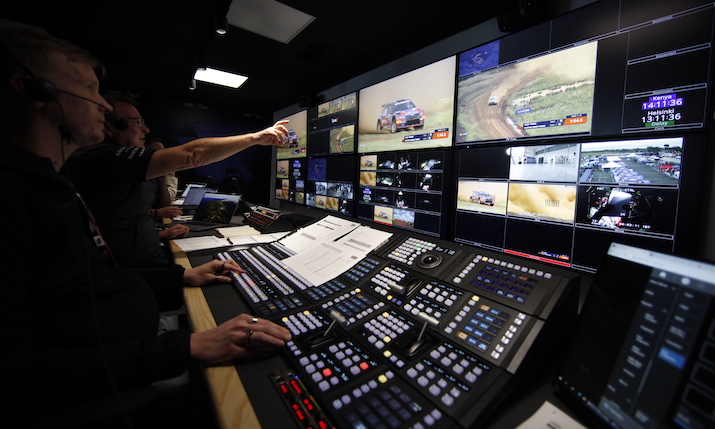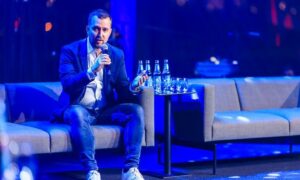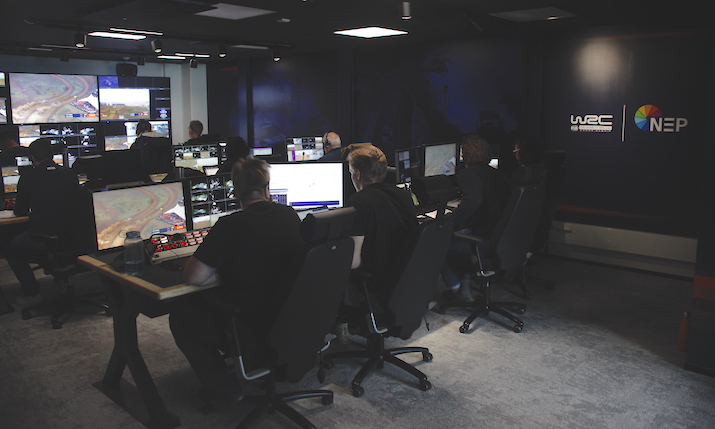The path to Porto: WRC readies for iconic Rally de Portugal

After Monte Carlo, Sweden, Kenya and Croatia, the FIA World Rally Championship (WRC) moves to Portugal on 9 May for the start of the European gravel phase and promises spectacle in and around the scenic city of Porto.
As well as being the biggest sporting event held annually in Portugal, the Rally de Portugal is ranked as one of the championship’s classic events with challenging stages including the legendary Fafe jump before the finish. Belgium’s Thierry Neuville, who drives for Hyundai, heads into the event championship leader.
“Rally de Portugal is a really big broadcast for us. It’s a spectacular rally and one of our biggest in terms of on-site audience attendance,” says Florian Ruth, senior director content & communication at rights holder WRC Promotor.
Difficult stages
This year’s course is made up of 22 stages, more than any here since 2012, spread across a large geographic area and reaching a total length of 1,690km. This includes a night stage in the host city itself around the maze of beautiful streets converging on the river Douro and the famous Dom Luís metal arch bridge.
This makes the event logistically complex.
“We have a very experienced team on the ground and a very good partner with [Portuguese national broadcaster] RTP with whom we have an excellent relationship to make a great co-production,” Ruth adds.

Florian Ruth
On the ground, RTP is supporting WRC with production facilities particularly for the Porto night stage. WRC runs four OB vans across the different stages with the live world feed gallery produced at WRC TV’s production hub in Helsinki managed by technical production provider NEP Finland.
Aerial coverage is provided by two helis (one with Cineflex, another carrying Shotover) and a pair of drones. These are just four of over 100 camera sources. Each of the first 15 cars are fitted with three to four onboards (around 45 onboards in total). These are bespoke builds developed by NEP for the WRC.
For main stage coverage feeds from the onboards, heli and some selected ground cameras are relayed via a relay plane to Helsinki. This isn’t the only connectivity pathway.
Ruth explains: “We can send feeds from the OB trucks via the plane and we can send line cuts from the trucks via satellite and also via LiveU. For example, we transmit all the live TV stages of the main race on satellite. Then, when the support categories [WRC2 and WRC3] begin, we switch to RF contribution. In addition, we have a variety of other camera crew also providing feeds via LiveU. All of RTP’s feeds are contributed over domestic fibre, managed by Tata Communications.”
In Helsinki, WRC teams produce the world feed adding commentary, graphics and final mix before distributing to right holders via fibre, by SRT streams or via satellite.
Races are produced in full HD encoded in HEVC, still considered by WRC and most leading live sports producers as a less complex production format than four channels of HD for 4K UHD.
Capturing the excitement
Editorially, a chief goal of WRC coverage is to combine the action on the circuit and in the cars with the excitement of the live event. To do this it selects camera positions from which it can pan from racing action to emotion in the crowd.
“The stadium stages of the Rally de Portugal in particular, will focus a lot on the crowd atmosphere. We expect 30,000-40,000 spectators and we want to see their emotion,” he adds.

Audio comms between driver and co-driver is a unique aspect to this motorsport and one which WRC coverage leans into. A multimedia box installed under the driver’s seat records driver and co-driver exchanges and transmits them via the plane back to the Helsinki base. External mics on the car, positioned to pick up the engine as well as the sound of gravel (rocky or sandy) terrain, are also fed back from the car. Additional audio is gathered from mics arrayed around the circuit and among spectators.
Sunday’s decisive stage will be made up of double passes through the 19.91km of Cabeceiras de Basto, of which 12.6km are completely new, and the iconic 11.18km of Fafe, attended by 100,000 people many of whom will have stayed to party overnight. The hillsides overlooking the sweeping bends that precede it are a magnet for fans.
“The stadium stages of the Rally de Portugal in particular will focus a lot on the crowd atmosphere. We expect 30,000-40,000 spectators and we want to see their emotion”
“When the first car comes through, they sing like a football crowd and that is what we want to hear and transmit,” says Ruth.
In all the team will produce 22 to 25 hours of live coverage across the four-day event culled from over 400 hours of total content. That translates to between 15TB and 20TB of material.
All key footage is transferred via fibre to the Helsinki hub. There the WRC produces daily highlights, news packages, digital clips, social media content and assets all of which lands in a new digital archive system launched in conjunction with Moments Lab (formerly Newsbridge). This WRC Championship is accessible to rights holders, broadcasters and sponsors.
DAZN deal
Last August, the WRC combined its various distribution platforms into Rally.TV, a 24/7 linear and OTT home of all rally and rallycross events. Its broadcast strategy is to serve rights holders and grow the audience for the product, which makes a recent carriage deal with DAZN significant. Rally de Portugal marks the start of its involvement.
“As our co-operation with them is just about to start, DAZN first need to learn our product but we are having good conversations with them and they have some good ideas. Their editorial teams are very promising and the promotion they will do for us will help grow the championship,” says Ruth.
Six of the 22 stages of Rally de Portugal are packaged as live TV stages for distribution on mainstream channels.
“The live TV stages are where we do wider storytelling, character building and updates as to what has happened in the rally so far. If you’re not so deep into watching every moment of every stage we can catch a broader audience,” he adds.
The competition is a race against the clock rather than head-to-head on the track so the editorial leans into the personalities of the drivers and in particular the relationship between driver and co-driver in the cockpit.
“That’s an aspect we focus on a lot in our storytelling because it sets us apart from every other motorsport,” Ruth says.
WRC Promoter is also keen to enrich fan understanding with virtual overlays and time and section comparisons.
“We are showcasing the pinnacle of world rally drivers in cars which are so competitive that even when racing over 20+km to the limit the difference between them at the end is just tenths of a second,” Ruth says. “We are trying more and more to visualise the differences. Every millimetre and every centimetre on every turn counts and we are trying with digital enhancements to make this more and more visible to the viewer.”
Remote production
Production moved to a remote model in 2022 and it is proving successful on several levels, one of which is improved sustainability.
Ruth says the WRC is conscious that its CO2 footprint is being monitored and that its remote production has already had a substantive positive impact.
“Simply in terms of plane travel there’s a lot less people and freight we have to fly. We have reduced our emissions a lot”, he reveals.
There is, of course, a cost benefit in not transporting all the facilities and people to every location but one plus “more important than cost efficiency” is production resiliency, according to Ruth. To produce a rally in the middle of a safari park live from Helsinki was an ambition WRC had long wanted to achieve, Ruth says, and it was achieved for the first time last year with the WRC Safari Rally Kenya, and successfully repeated this year.
“The first year we travelled to Kenya the production facilities suffered. It’s not only Kenya. Mexico too. The more you rig in remote locations the greater the risk of failure,” he explains.
“Every millimetre and every centimetre on every turn counts and we are trying with digital enhancements to make this more and more visible to the viewer”
Driving on bumpy roads tended to loosen screws in gear, EVS kit needed dedusting of sand, 40º heat doesn’t help either.
Now, with all the essential production parts moved offsite there is less need to cable everything and less need to check and double check. He continues: “There always the chance of a broken connector on-site so to remove all that risk and be in a very stable environment where everything is perfectly connected and tested in a state-of-the-art IP production hub makes a big difference.”
Looking ahead, in June the WRC is returning to Poland, a country with a strong fanbase (it lost its place on the calendar due to repeated breaches of spectator safety) and it’s launching a new rally in Latvia in July.
There’s also WRC Finland in August “our Monaco Grand Prix”, Ruth says, “one of the most prestigious on the calendar”. Indeed, some of the most spectacular rallies in terms of landscape are still to come, with teams set to race at high altitude in Chile before the season finale in Japan, home of reigning World Champions Toyota Gazoo Racing and one of their two full-time drivers, Takamoto Katsuta.
 Create Share Engage 2024, sponsored by Appear, is a one-day event for sports federations, leagues, associations, clubs and other rights owners, as well as broadcasters, agencies and producers, that will focus on creating and distributing sports content, and engaging fans, across social media, streaming and other digital platforms.
Create Share Engage 2024, sponsored by Appear, is a one-day event for sports federations, leagues, associations, clubs and other rights owners, as well as broadcasters, agencies and producers, that will focus on creating and distributing sports content, and engaging fans, across social media, streaming and other digital platforms.
For more information and to register click here

